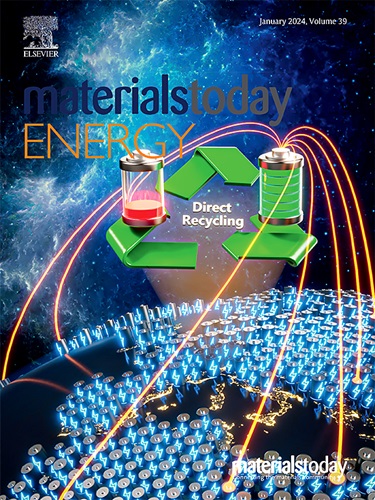设计delafossite CuAl1-xTMxO2固溶体:3d过渡金属自旋态在光(电)催化性能中的作用
IF 8.6
2区 材料科学
Q1 CHEMISTRY, PHYSICAL
引用次数: 0
摘要
本研究深入探讨了三维过渡金属(TM)自旋态对 CuAlTMO 固溶体的结构和电子特性的影响,重点关注它们对光(电)催化性能的影响。研究发现,与 TM 有关的 Jahn-Teller 畸变是决定晶格参数和光(电)催化性能的关键因素。没有 Jahn-Teller 畸变的固溶体符合 Vegard 定律,而有强畸变的固溶体则出现偏差,这表明 TMO 八面体畸变对溶解度和晶格参数有影响。具有弱贾恩-泰勒畸变的固溶体的电子结构受 O-Cu-O 和 TMO 晶场的支配,这导致带隙变窄和导带最小值(CBM)降低,从而影响氢演化势。特别是 CuAlCrO,由于其均衡的光吸收和有效的电荷载流子分离,其光电流密度和氢气产生率显著提高。相比之下,CuAlFeO 中的弱 Jahn-Teller 畸变会导致 CBM 处的局部电子态,从而降低载流子迁移率。具有强贾恩-泰勒畸变的固溶体,如 CuAlTMO(TM = Mn 和 Ni),显示出从半导体到半金属的一系列电子特性,其中半金属 CuAlMnO 能够吸收红外光并高效光催化制氢和制氧。本文章由计算机程序翻译,如有差异,请以英文原文为准。
Designing delafossite CuAl1-xTMxO2 solid solutions: the role of 3d transition metal spin states in photo(electro)catalytic performance
This study delves into the effects of 3d transition metal (TM) spin states on the structural and electronic properties of CuAlTMO solid solutions, focusing on their implications for photo(electro)catalytic performance. The research reveals that the Jahn–Teller distortion, associated with TM, is a critical factor in determining the lattice parameters and photo(electro)catalytic performances. Solid solutions without Jahn–Teller distortion adhere to Vegard's law, whereas those with strong distortion exhibit deviations, indicating the influence of TMO octahedral distortion on solubility and lattice parameters. The electronic structure of solid solutions with weak Jahn–Teller distortion is governed by the O–Cu–O and TMO crystal fields, which leads to a narrowed bandgap and reduced conduction band minimum (CBM), impacting the hydrogen evolution potential. In particular, the CuAlCrO shows a significant enhancement in photocurrent density and hydrogen production rate due to its balanced light absorption and effective charge carrier separation. In contrast, the weak Jahn–Teller distortion in CuAlFeO results in localized electronic states at CBM, leading to diminished carrier mobility. Solid solutions with strong Jahn–Teller distortion, such as CuAlTMO (TM = Mn and Ni), display a range of electronic properties from semiconductor to semimetallic, with the semimetallic CuAlMnO capable of infrared light absorption and efficient photocatalytic hydrogen and oxygen production.
求助全文
通过发布文献求助,成功后即可免费获取论文全文。
去求助
来源期刊

Materials Today Energy
Materials Science-Materials Science (miscellaneous)
CiteScore
15.10
自引率
7.50%
发文量
291
审稿时长
15 days
期刊介绍:
Materials Today Energy is a multi-disciplinary, rapid-publication journal focused on all aspects of materials for energy.
Materials Today Energy provides a forum for the discussion of high quality research that is helping define the inclusive, growing field of energy materials.
Part of the Materials Today family, Materials Today Energy offers authors rigorous peer review, rapid decisions, and high visibility. The editors welcome comprehensive articles, short communications and reviews on both theoretical and experimental work in relation to energy harvesting, conversion, storage and distribution, on topics including but not limited to:
-Solar energy conversion
-Hydrogen generation
-Photocatalysis
-Thermoelectric materials and devices
-Materials for nuclear energy applications
-Materials for Energy Storage
-Environment protection
-Sustainable and green materials
 求助内容:
求助内容: 应助结果提醒方式:
应助结果提醒方式:


